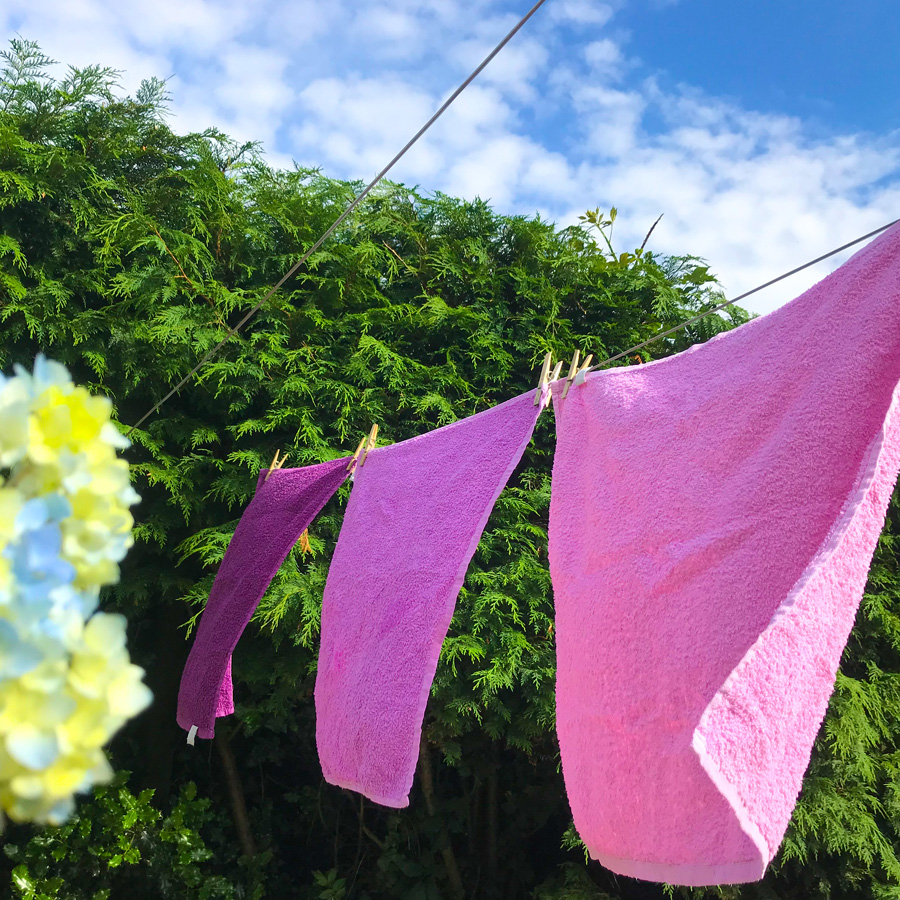Drying Nappies
How to Dry Your Cloth Nappies
Drying cloth nappies need not be difficult, but does require some thought, especially in areas with unreliable weather or where drying facilities are limited. Limited drying facilities can be one of the most significant constraints on the choice of suitable nappy system. You should consider a drying option which best suits your current lifestyle, since it is unlikely that you are suddenly going to become keen on using the outside line, for instance, if you have not done so before.
In general order of preference, these are the best ways to dry your nappies:
- Outside on the line - the sun is a natural bleach.
- Ceiling drying rack.
- Airing cupboard.
- In front of an Aga or other similar oven (or old fashioned stove).
- Freestanding or overbath dryer - a dryer is best stood in a well-ventilated room such as a conservatory or bedroom, as bathrooms often have too damp an atmosphere to dry effectively.
- Tumble drier - makes nappies feel nice and soft, but works out expensive and also shortens the life span of your nappies by taking out the pile gradually. When you empty the fluff from your tumble dryer filter, that fluff is lost fabric fibres and therefore absorbency. You could give your nappies no more than 10 minutes in the tumble drier and then finish them off in one of the other ways listed. This way you get some of the softness without the cost. Other people swear by keeping the 10 minute tumble dry for the end of the drying period, rather than the beginning, but that is difficult to time. Tumble drying should be avoided for any waterproof PUL covers which includes all in ones. If you have no choice but to tumble dry make sure you only dry any bamboo fabrics or waterproof layers on a low heat.
- Near a radiator - nappies will feel quite hard, but can be shaken out to soften them up a bit. Never dry directly on a radiator as they will get too hot and burn fabrics, especially delicate bamboo.
- Terries and prefolds can also be ironed dry - many shaped nappies cannot be, either because they are too thick, or they contain some material which should not be ironed. This option is bottom of the list because it involves the serious disadvantage of requiring some effort on your part! Never iron wraps. In parts of Africa ironing is required to kill Putsi Fly eggs laid on wet laundry. If you live in one of these Putsi Fly areas please get in touch with us so we can advise you of the correct and safest washing methods for your region.
Note that you should avoid drying any clothes in a room used by anyone with a sensitivity to house dust mites, as these love to breed in the warm air produced by damp clothing.
Drying Facilities and Options
Air drying is always the preferred option to dry your nappies; it will maintain their lifespan by not adding the mechanical wear of tumble drying, and is more cost effective from a financial and environmental point of view. If you prefer to air dry in general, you could put your nappies in the tumble drier for 10 minutes, as this will keep them softer. Air dried nappies can go a bit stiff in hard water areas, although this doesn't matter at all if you use a fleece liner. As soon as your baby wees, they soften up anyway. Before air-drying your nappies, give them a good shake first, as this will soften them considerably. Equally, a shake when they are dry will also help.
Outdoor Drying
If you have a rotary drier outside, you could consider one of those plastic covers which enable you to hang washing out to dry even if it is raining. On a rotary drier, in damp air the washing will take a long time to dry, unless it is pretty windy. An old-fashioned long line high up on a pulley system is by far the fastest way to dry anything outdoors, as it lifts the nappies out of the shelter of the garden and right into good air currents. One advantage of outside drying is that the sun (if it shines!) is a natural bleach, which can work wonders on stains.
Ceiling Airers and Similar
A ceiling airer is by far the most practical indoor air drying method, as you can dry a large number of nappies or any other clothes, well out of everyone's way, with plenty of room for warm air to circulate. If you do not have one, but have a space where it would be practical to install one, I recommend you take a look at Sheilamaid.
Many modern houses, however, do not have the high ceilings that a ceiling airer requires, or indeed it may simply look out of place. Lakeland Limited offer a number of solutions at a good price: a traditional ceiling airer, a wall-mounted bespoke airer (which telescopes away) and a freestanding 'hangaway' airer (please note that they are listed under a different name than 'airer' by Lakeland). These three options are well worth considering and are comparatively inexpensive. If using a heated airer then we recommend that you don't place your nappies directly on the airer, so place another piece of material (like a tea towel or muslin) between the airer and nappy. This is because all heated airers can reach different temperatures and we can not guarantee that any would not get too hot.
Airing Cupboard
If it is a warm one, using an airing cupboard to dry your nappies is ideal, as long as you can keep one rack free, so you can hang the nappies over the slats - spread out as much as possible. The airing cupboard will prove especially useful in the winter months, when the central heating is on. In the summer months, or if heavily insulated, the lack of warmth and of air movement might not make it your first choice.
Aga Drying
With an Aga or similar, you will no doubt have a permanently warm kitchen. Combine a range cooker with a ceiling airer, and there really is no need for a tumble drier! You can also dry your nappies on the bar in front of the cooker, but be careful to keep fastenings (especially any plastic poppers) away from direct heat. As with drying on a radiator, turning over the nappies periodically will speed their drying considerably. Try to avoid putting too many on at once.
Tumble Drying
Regular tumble drying of cloth nappies largely outweighs the environmental benefits of reduced landfill, so should be avoided if this is a major concern.
A washing machine with a higher speed spin will reduce the amount of drying needed. However, I would recommend that you keep the spin speed around 1000, because higher than this may damage some nappies, or at least make the fabric go tatty. You will know from your own experience of washing your clothes how fierce your spin facility is! Having a tumble drier is the ultimate last resort, as you are then not limited to having to wait for your nappies to air dry. However, regular use of the tumble drier will of course increase the cost. To speed drying times, put a dry towel in with the nappies, as this absorbs the condensation the nappies produce. Try to avoid putting too many nappies in the drier at one time, in order to keep the drying time down.
If you have a combined washer/drier, and intend to use the drier, you will need to empty the washing machine after it has finished, and shake the nappies before putting them back in. Otherwise, some will tend to stick to the side after the last spin cycle, and these will not dry easily. You may need to split them into two loads to dry, as the drying capacity of these machines is much lower than the washing capacity. If you do not have the backup of a tumble drier, it would be advisable to avoid slow drying bamboo fabrics.
Radiator Drying
Radiators offer a good direct source of heat at minimal extra cost, as in the winter you are likely to have the heating on anyway. It isn't recommended to dry your nappies directly on the radiator, as it can get too hot and may burn your nappy fabrics, especially delicate bamboo and PUL. Instead, you can put your nappies on a clothes horse in front of the radiator, or invest in the small airers that hook over the top of the radiator.
Dehumidifiers
An electric dehumidifier can be really useful for families living in small damp houses and flats where there's no room for a tumble dryer. It is usually more cost effective than a tumble dryer and can either be run all the time to try to keep the whole house drier, or just run when washing is drying.
What if your nappies feel stiff?
With washing, all nappies will get stiffer than they were when new, although it does help to live in a soft water area (e.g. Wales!). Shaped terries with a stretch agent (e.g. Mother-ease) in them or microfibre nappies such as the Teddy will tend not to go as hard as old fashioned terries. Bear in mind, however, that your baby will not feel the material directly against their bottom anyway, because there will be a liner on top. Also, as soon as baby wees, the whole thing softens up.
If you are concerned that your nappies have got a bit stiff or crispy over time, there are a few ways to soften them up. Tumble drying is great, but does have the potential for affecting the longevity of your nappies as above. If you don't have a tumble dryer, you can give the nappies a good shake or rub together when they come out of the washing machine, and again towards the end of drying. This will fluff up the fibres and make the nappies feel softer to the touch.



